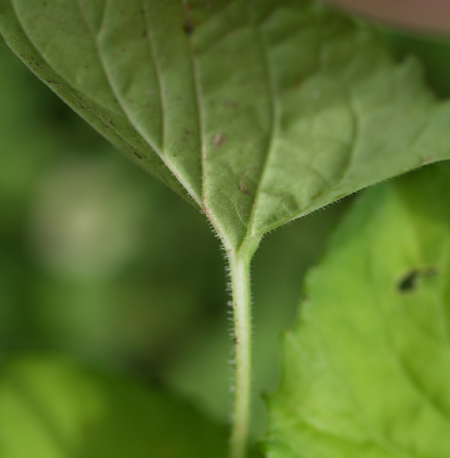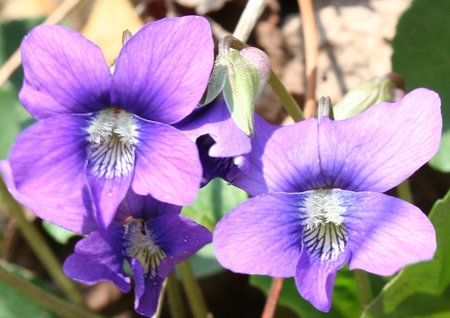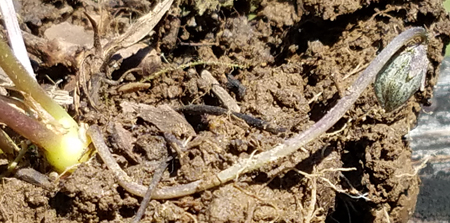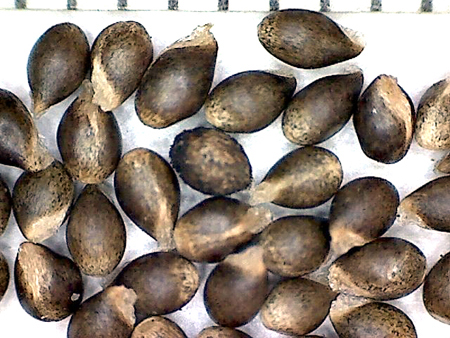Viola sororia Willd. [sensu stricto]
Common names:
Common Wood Violet, Woolly Blue Violet
Synonyms:
Viola sororia Willd., Hort. Berol. [Willdenow] 1(6): pl. 72. Apr 1806; Viola palmata L. var. sororia (Willd.) Pollard, Bot. Gaz. 26: 332. 1898; Viola cucullata Aiton var. sororia (Willd.) Torr. & A.Gray, Fl. N. Amer. 1(1): 137. 1838. Type: "Habitat in America boreali" [protologue], [U.S.A.], Pennsylvania, [no date], [no collector], (lectotype (designated by Nir Gil-ad, Boissiera 53: 81. 1997): sheet No. 3, B-W4898, photo: MICH (n.v.)).
Viola sororia Willd. f. pallida Seymour, Fl. Vermont, ed. 4: 382. 1969
Viola sororia Willd. var. incognita J.Lacey, Sida 3: 312. 1969
Viola sororia Willd. f. beckwithae House, New York State Mus. Bull. 243-244: 40. 1923
Viola palmata L. var. asarifolia (Pursh) House, Torreya 2: 68. 1902; Viola asarifolia Pursh, Fl. Amer. sept. 2: 732 [supplement]. 1813
Viola nodosa Greene, Pittonia 4: 296. 1901
Viola dicksonii Greene, Pittonia 4: 65. 1899
Viola cuspidata Greene, Pittonia 3: 314. 1898
Viola palmata L. var. variegata Stowell, J. Trenton Nat. Hist. Soc. 1: 26. 1887
Viola barbata Willd. ex Schult., in Roemer & Schultes, in Roemer & Schultes, Syst. veg. 5: 362. 1819; Viola barbata Muhl.,Cat. pl. Amer. sept., ed. 1: 25. 1813 [nomen nudum]. TYPE: "Pensylvania", [no date], W. Muhlenberg s.n. (TYPE: B-W04897-010, internet image!).
Description:
Foliage, peduncles and calyces green, leaves often turning yellow-green in fruit, foliage and peduncles moderately to densely hirsute, calyces ciliate in basal 1/2(2/3); leaf blade outline ovate, apex acute to obtuse, margins prominently incurved-serrate with teeth lower and more remote near apex, appressed-ciliate; seeds 1.5–2.6 × 0.9–1.6 mm, dark gray to dark grayish-brown or blackish, appearing unspotted or with small usually weak blackish streaks. Other features same as the species complex.
Ecology:
Moist loamy or clayey soils in dry-mesic, mesic and wet-mesic forests, on slopes, coves, or terraces along streams and rivers; also in lawns, meadows and roadsides.
Distribution:
Widely distributed, throughout the range of the species complex.
Rarity:
None.
Phenology:
Same as the species complex.
Affinities:
Same as the species complex.
Hybrids:
Hybridizes with V. affinis (Brainerd 1904b, 1924, Gaiser and Moore 1966, Haines et al. 2011), V. baxteri (Brainerd 1924, Harvey Ballard pers. comm.), V. brittoniana (Brainerd 1924, Haines et al. 2011), V. communis [or possibly V. "sororia glabrous" or V. "sororia hirsutula-like"] (Dowell 1910, Greene 1914, Brainerd 1924, House 1924, Henry 1953a), V. cucullata (Brainerd 1904b, 1924, House 1924, Henry 1953a, Haines et al. 2011), V. emarginata (Brainerd 1924), V. fimbriatula (Brainerd 1904b, 1924, House 1924, Henry 1953a, Haines et al. 2011), V. hirsutula (Brainerd 1924, Henry 1953a), V. latiuscula (Brainerd 1924, House 1924), V. missouriensis (Brainerd 1924), V. monacanora (Hastings 2018, Harvey Ballard pers. comm.), V. nephrophylla (Brainerd 1924, Haines et al. 2011), V. palmata var. palmata (Ballard 2013), V. palmata var. triloba (Brainerd 1912, 1924, Scoggan 1978, Haines et al. 2011, Harvey Ballard pers. comm.), V. "palmata pseudo-stoneana" (Hastings 2018, Harvey Ballard pers. comm.), V. pedatifida (Greene 1898a, 1903a, 1906b, Brainerd 1913a, 1924, Ballard 1995, 2013), V. sagittata (Brainerd 1924), V. septentrionalis (Brainerd 1904b, 1924), V. stoneana (Harvey Ballard pers. comm.), V. subsinuata sensu stricto (House 1923, 1924, Brainerd 1924, Haines et al. 2011, Hastings 2018, Harvey Ballard pers. comm.), and V. "subsinuata Chapel Hill" (Harvey Ballard pers. comm.). Brainerd reported that these exhibit intermediate or recombinant characteristics of foliage, chasmogamous flowers, cleistogamous capsules and seeds (where these did not abort). He noted that all hybrids fail to reproduce by chasmogamous flowers, and all produce abortive cleistogamous capsules or capsules with a substantially reduced proportion of viable seeds or very few seeds at all.
Comments:
Brainerd (1921b), Brainerd Baird (1942), Fernald (1950), Henry (1953a), Alexander (1963), Russell (1965), Scoggan (1978), Strausbaugh and Core (1978), Gil-ad (1995, 1997, 1998), and Weakley et al. (2012) distinguished the present species from V. septentrionalis Greene. Gil-ad provided a host of macromorphological characteristics and supporting micromorphological traits to uphold their recognition as distinct species. Gleason and Cronquist (1991), Ballard (1995, 2000), Haines et al. (2011), Voss and Reznicek (2012), and Little and McKinney (2015) synonymized the latter under V. sororia, while McKinney (1992) placed the latter under V. sororia var. sororia. Brainerd, Brainerd Baird, Fernald, Henry, Alexander, and Strausbaugh and Core segregated all strictly to essentially glabrous populations as V. papilionacea Pursh, including V. pratincola Greene described from southern Minnesota without formal recognition. Russell (1965) took a different approach and upheld V. pratincola as a distinct species, mapping it broadly from the eastern Great Plains and western Midwest, distinguishing it from a broadly delimited and more eastern V. sororia into which he included all other glabrous or glabrate variants. He argued that V. pratincola was morphologically different from V. sororia and related variants and inhabited open, prairie-like habitats and prairie-forest borders, often becoming quite weedy and common along roadsides, railroad rights-of-way and lawns. He regarded other plants previously called V. papilionacea as nothing more than glabrate to glabrous V. sororia. Swink and Wilhelm (1979), Gleason and Cronquist (1991), Ballard (1995, 2000), Weakley et al. (2012), and Little and McKinney (2015) recognized an even more broadly delimited V. sororia that included V. pratincola and all other glabrous or glabrate variants; while McKinney (1992) and McKinney and Russell (2002) placed everything under V. sororia var. sororia. Gil-ad studied specimens referred to V. papilionacea by Brainerd and found a diverse range of traits and a mixture of micromorphological traits suggestive of hybridization, with no unique traits. He excluded it as a series of hybrid derivatives. Similarly, he examined seeds from type material and found micromorphological features resembling those of V. nephrophylla and V. affinis; seeds of another specimen from Iowa possessed features suggestive of V. nephrophylla and V. sororia. Finding no unique macromorphological features and micromorphological features apparently blending those of other species, he concluded that V. pratincola represented a hybrid derivative. Recent field and herbarium studies of the Sororia species group have supported Gil-ad's taxonomic approach to delineate V. sororia very narrowly and to distinguish it from V. septentrionalis and from plants with strictly or essentially glabrous foliage and eciliate calyces. However, more extensive field and herbarium studies and substantially broader sampling of macromorphological and micromorphological characters have demonstrated the existence of multiple taxa from the heterogeneous "papilionacea" assemblage previously stuck for the most part under V. sororia, all of which are fertile and fully distinct on their own merit. These are recognized in this treatment as V. communis Pollard, V. domestica E.P.Bicknell and V. pratincola Greene, all of which are placed in the Cucullata species group. Two additional taxa of V. sororia are currently under study, the glabrous variant and the hirsutuloides variant.
Its broadly mesic (dry-mesic to wet-mesic) forested microhabitats and broad eastern North American range bring V. sororia sensu stricto into contact with the majority of other Borealiamericanae violets, with which it very readily hybridizes. The hybrids range from subfertile to nearly sterile. See the Hybrids section for a comprehensive list. This taxon is mapped with the two variants for the V. sororia species complex, due to very fragmentary knowledge of the distributions of the individual taxa under study.
Literature Cited:
Alexander, E. J. 1963. Violaceae. In Gleason, H. A., The new Britton and Brown illustrated flora of the northeastern United States and adjacent Canada. Hafner Publishing Co., Inc., New York, NY. 552-567.
Ballard Jr., H. E. 1995 ["1994"]. Violets of Michigan. Michigan Botanist 33: 131-199.
Ballard Jr., H. E. 2000. Violaceae. In Rhoads, A. (ed.). Flora of Pennsylvania. University of Pennsylvania Press, Philadelphia, PA. 700-710.
Ballard Jr., H. E. 2013. Violaceae. In Yatskievych, G., Flora of Missouri. Missouri Botanical Garden Press, St. Louis, MO. 1218-1243.
Brainerd, E. 1904b. Notes on New England violets. Rhodora 6: 8-17.
Brainerd, E. 1912. Violet hybrids between species of the palmata group. Bulletin of the Torrey Botanical Club 39: 85-97.
Brainerd, E. 1913a. Four hybrids of Viola pedatifida. Bulletin of the Torrey Botanical Club 40: 249-260.
Brainerd, E. 1921b. Violets of North America. Vermont Agricultural Experiment Station Bulletin 224: 1-172.
Brainerd, E. 1924. The natural violet hybrids of North America. Vermont Agricultural Experiment Station Bulletin 239.
Brainerd Baird, V. 1942. Wild violets of North America. University of California Press, Berkeley, CA.
Dowell, P. 1910. The violets of Staten Island. Bulletin of the Torrey Botanical Club 37: 163–179.
Fernald, M. L. 1950. Violaceae. In Gray's Manual of Botany, 8th ed. American Book Company, New York, NY. 1022-1042.
Gaiser, L. O., and R. J. Moore. 1966. A survey of the vascular plants of Lambton County, Ontario. Plant Res. Inst. Can. Dept. Agric. Ottawa, Ont. 122 pp.
Gil-ad, N. L. 1995. Systematics and evolution of Viola L. subsection Boreali-Americanae (W. Becker) Brizicky. Ph.D. dissertation. University of Michigan, Ann Arbor, MI.
Gil-ad, N. L. 1997. Systematics of Viola subsection Boreali-Americanae. Boissiera 53: 1-130.
Gil-ad, N. L. 1998. The micromorphologies of seed coats and petal trichomes of the taxa of Viola subsect. Boreali-Americanae (Violaceae) and their utility in discerning orthospecies from hybrids. Brittonia 50: 91-121.
Gleason, H. A., and A. Cronquist. 1991. Violaceae. In Manual of vascular plants of northeastern United States and adjacent Canada, 2nd ed. New York Botanical Garden, Bronx, NY. 157-163.
Greene, E. L. 1898a. New or noteworthy species.-XXI. Pittonia 3: 257-263.
Greene, E. L. 1903a. The genus Viola in Minnesota-I. Pittonia 5: 115-133.
Greene, E. L. 1906b. Mutations in Viola. Leaflets of Botanical Observation and Criticism 1: 182-187.
Greene, E. L. 1914. Violets of the District of Columbia.-1. Cybele Columbiana 1(1): 7-33.
Haines, A., E. Farnsworth, and G. Morrison. 2011. Violaceae. In Flora Novae Angliae. Yale University Press, New Haven, CT. 873-886.
Hastings, J. L. 2018. Systematic and ecological studies of the Viola subsinuata species complex. M.S. thesis. Ohio University, Athens, OH.
Henry, L. K. 1953a. The Violaceae in western Pennsylvania. Castanea 18(2): 37-59.
House, H. D. 1923 ["1921"]. Local flora notes VIII. New York State Museum Bulletin 243-244: 13-58.
House, H. D. 1924. Annotated list of the ferns and flowering plants of New York state. Family 83 Violaceae. New York State Museum Bulletin 254: 499-512.
Little, R. J., and L. E. McKinney. 2015. Violaceae. In Flora of North America: Cucurbitaceae to Droseraceae, 106. Oxford University Press, New York, NY.
McKinney, L. E. 1992. A taxonomic revision of the acaulescent blue violets (Viola) of North America. Sida, Botanical Miscellany 7: 1-60.
McKinney, L. E., and N. H. Russell. 2002. Violaceae of the southeastern United States. Castanea 67: 369-379.
Russell, N. H. 1955c. The taxonomy of the acaulescent white violets. American Midland Naturalist 54: 481-494.
Russell, N. H. 1965. Violets (Viola) of the central and eastern United States: An introductory survey. Sida 2: 1-113.
Scoggan, H. J. 1978. Violaceae. In Flora of Canada, Part 3–Dicotyledoneae (Saururaceae to Violaceae). National Museums of Canada. Ottawa, Canada. 1103-1115.
Strausbaugh, P. D., and E. L. Core. 1978. Violaceae. In Flora of West Virginia, 2nd ed. Seneca Books, Inc., Morgantown, WV. 644-658.
Swink, F., and G. Wilhelm. 1979. Violaceae. In Plants of the Chicago region, 2nd ed. revised and expanded. Morton Arboretum, Lisle, IL. 384, 801-810.
Voss, E. G., and A. A. Reznicek. 2012. Violaceae. In Field manual of Michigan flora. The University of Michigan Press, Ann Arbor, MI. 913-922.
Weakley, A. S., J. C. Ludwig, and J. F. Townsend. 2012. Violaceae. In Flora of Virginia. BRIT Press, Fort Worth, TX. 963-975.

Chasmogamous flowering habit by Andrew Gibson, "Buckeye Botanist" website

Leaves between chasmogamous flower and fruit by Harvey Ballard

Leaf showing pubescence of lower surface of blade and petiole by Harvey Ballard

Chasmogamous flower front view by Andrew Gibson

Cleistogamous fruit by Harvey Ballard

Seeds from herbarium specimen: VT, Middlebury, moist thicket near mountain, 31 Jul 1903, E. Brainerd 159 (NY)

Seeds from herbarium specimen: Transplanted from OH, Guernsey Co., Salt Fork State Park, 2015, H. Ballard 15-051Y (BHO)

Seeds from herbarium specimen: Transplanted from MI, Washtenaw Co., Steinbach Woods, 0.18 mi. E of South Dancer Rd., 0.36 mi. N of Liberty Rd., 2015, H. Ballard 15-046Y (BHO)